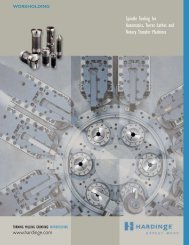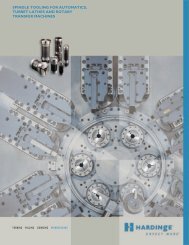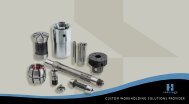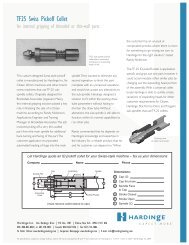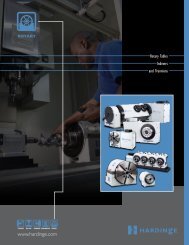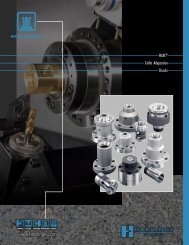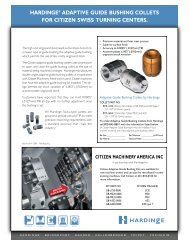Hardinge B160A DD100 Direct-Drive Rotary User Manual
Hardinge B160A DD100 Direct-Drive Rotary User Manual
Hardinge B160A DD100 Direct-Drive Rotary User Manual
You also want an ePaper? Increase the reach of your titles
YUMPU automatically turns print PDFs into web optimized ePapers that Google loves.
18<br />
<strong>DD100</strong> <strong>Direct</strong>-<strong>Drive</strong> <strong>Rotary</strong> Table Indexer <strong>User</strong> <strong>Manual</strong> B-160A<br />
Collet Installation for Fail-Safe Collet Closer<br />
To install a collet, align the collet keyway with the spindle key and insert the collet. Use the provided knurled tool to<br />
turn the back of the collet closer drawtube. Turn the drawtube several times to get the collet started in the drawtube.<br />
Actuate the air valve to put air in the closer and move the drawtube to the forward position, or open position.<br />
Continue to turn the drawtube until the collet grips the part and back the collet out of the drawtube ¼ to ½ of a turn<br />
so that the part easily slips in and out of the collet. Never try to turn the drawtube while the collet is gripping a part<br />
as the friction is too high inside the closer to allow the drawtube to turn. Never under any circumstances should<br />
a wrench be put on the drawtube knurled tool to aid in tightening or loosening a collet. Any method of<br />
adjusting a collet other than by hand can break the closer and void any warranty by <strong>Hardinge</strong> Inc. If at any time the<br />
drawtube is too hard to turn by hand, call <strong>Hardinge</strong> for assistance, do not use other tools to try and break it free.<br />
2.6 Tooling Locations<br />
The <strong>DD100</strong> is equipped with tooling points in order to speed<br />
setups. One of the most time-consuming procedures in setup<br />
is aligning the head with the table. On the mounting surfaces<br />
there are two 0.500"/12.7mm bored holes on 3.000"/76.2mm<br />
centers. The holes on the bottom surface are parallel to the<br />
spindle within 0.001"/0.025mm per 6 inches/152.5mm and on<br />
center within ±0.001"/0.025mm. By boring machine holes in<br />
your tooling plate, setups become routine. Using the tooling<br />
holes will also prevent the head from shifting on the mill table<br />
when the part is subjected to heavy cutting forces. On CNC<br />
mills, a machined stepped plug of 0.500"/12.7mm diameter one<br />
side and 0.625"/15.9mm on the other comes with the <strong>Hardinge</strong><br />
head. The 0.625"/15.9mm diameter fits into the T-slot of the<br />
mill table. This will give quick parallel alignment that will be<br />
close enough for most jobs.<br />
NOTE: 0.625"/15.9mm and 18mm plugs are supplied as<br />
standard. Plugs can be turned down to another diameter to<br />
accommodate tables with different slot dimensions.<br />
6.61<br />
(168)<br />
<strong>Hardinge</strong> Inc. One <strong>Hardinge</strong> <strong>Drive</strong>, Elmira, New York U.S.A. 14902-1507 800.843.8801 (Canada 800.468.5946) www.shophardinge.com<br />
Part No. BA -0009500-0160



